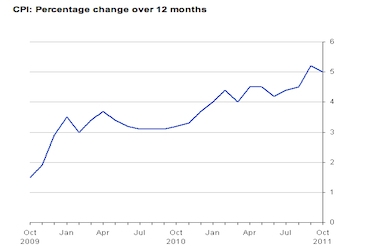
Inflation fell from 5.2 per cent to 5 per cent in October, according to the Office for National Statistics.
This was better than analysts had hoped as they had previously forecast a smaller fall to 5.1 per cent.
The fall to 5 per cent was the figure for the Consumer Prices Index. The Retail Prices Index, which includes house prices, similarly fell from 5.6 per cent to 5.4 per cent.
It is hoped this will be the start of a downward trend for inflation which has remained consistently high over the last year.
The largest downward pressures came from a 0.9 per cent fall in food prices and a 0.7 per cent fall in transport including a 6.0 per cent fall in the price of air fares.
Upward pressures came from increases in the cost of clothing which increased by 0.8 per cent and electricity and gas which increased by 1.5 and 1.4 per cent respectively.
This month’s figures included the price increases from the final two large utility companies to announce price changes. The other four companies increases were factored into last month’s figures.
In a letter to Chancellor George Osborne, Bank of England governor Mervyn King said he expects inflation to drop to two per cent in the next six months.
He said: “While we can be confident about the direction of change of inflation over the coming months, we remain uncertain about the precise pace and extent of the drop in inflation.
“It could fall back slowly if companies attempt to restore profit margins by raising their prices. There is significant further pass through from previous increases in import prices or the sustained period of above-target inflation becomes embedded in wage and price-setting behaviour.”
The Bank of England will publish its Inflation Report tomorrow with its predictions for future inflation and the economy.
• Want to receive a free weekly summary of the best news stories from our website? Just go to home page and submit your name and email address. If you are already logged in you will need to log out to see the e-newsletter sign up. You can then log in again.

